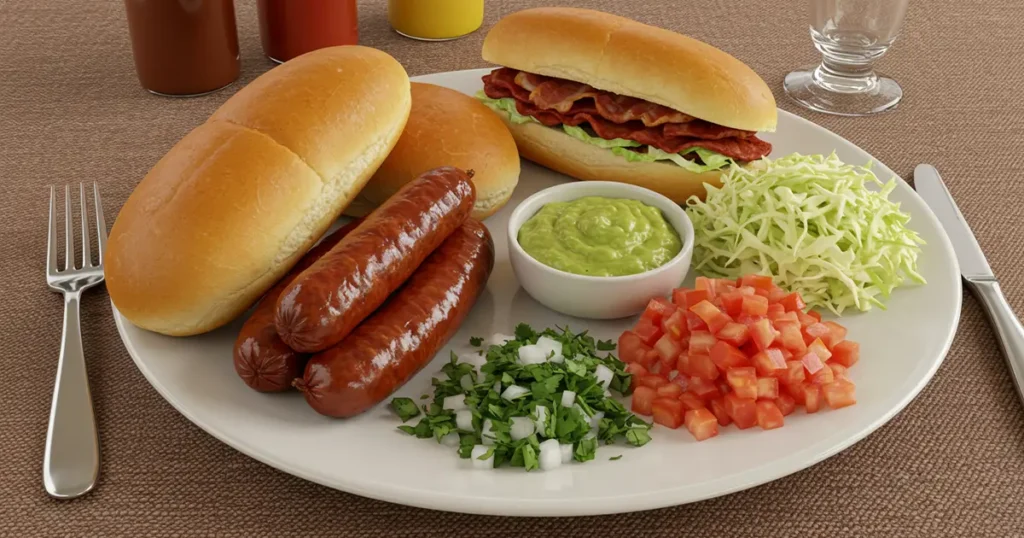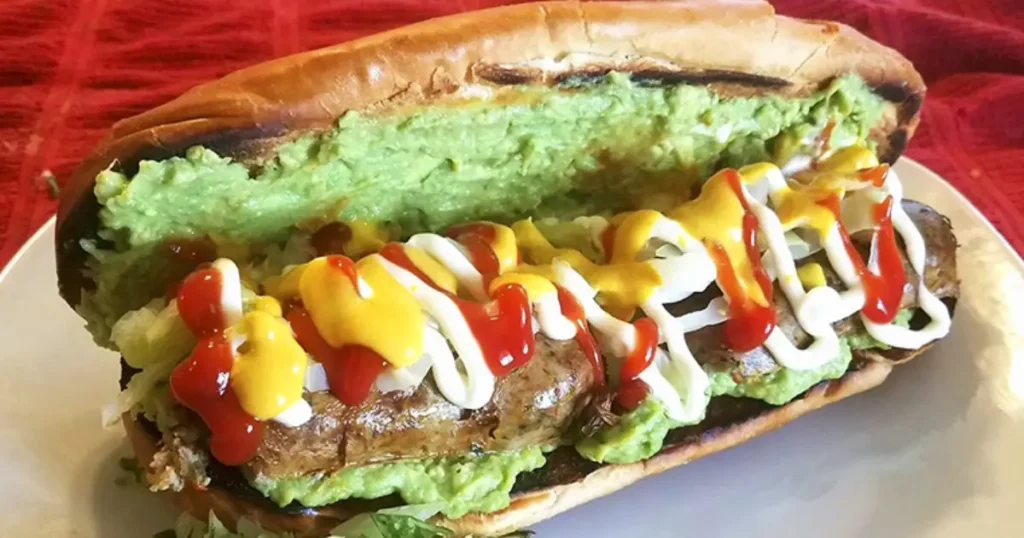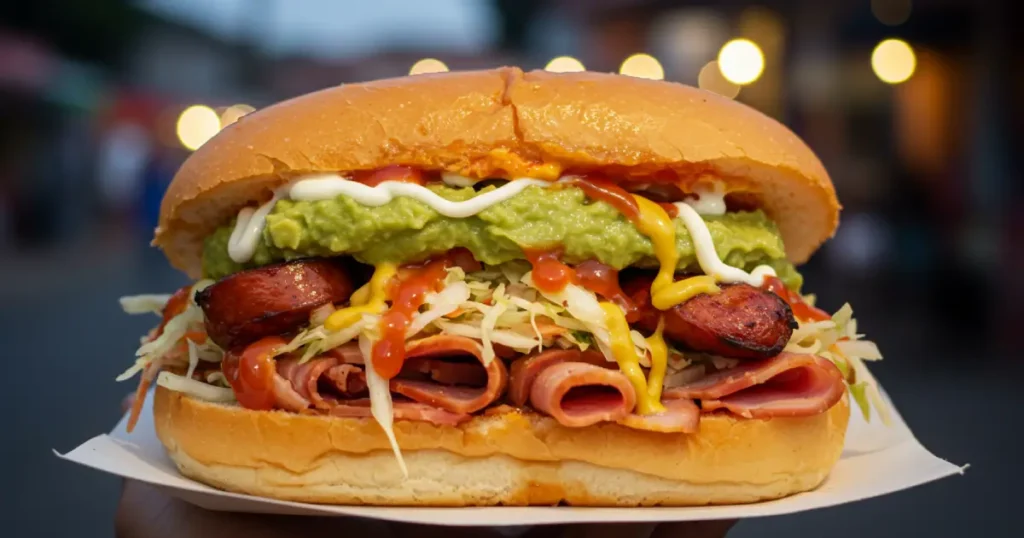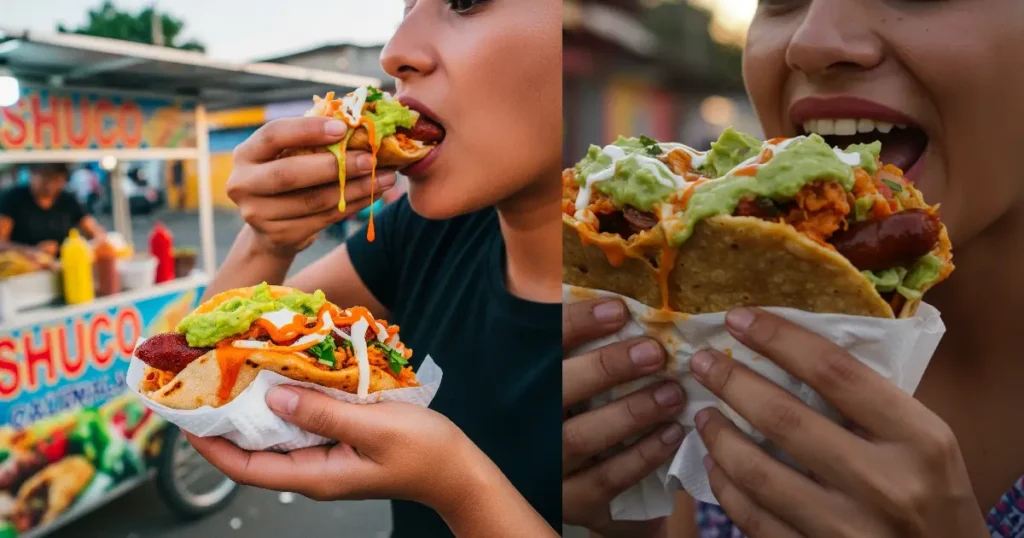Guatemalan Shucos: The Ultimate Guide to Guatemala Street Hot Dogs & Recipe

Guatemala, a land of vibrant culture, ancient Mayan history, and breathtaking landscapes, offers a culinary scene as rich and diverse as its heritage. While many travelers seek out traditional dishes like Pepián or Kak'ik, there's an undeniable king of the streets, a beloved, messy, and utterly delicious creation that captures the heart and soul of Guatemalan street food culture: the Guatemalan Shucos.
Far more than a simple hot dog, the shuco Guatemalteco is an experience, a flavor explosion, and a cherished national icon. Often affectionately referred to as dirties, these loaded hot dogs are a testament to Guatemalan ingenuity, offering a quick, satisfying, and incredibly flavorful meal at any time of day, but especially when late-night hunger pangs strike.
This article will take you on a journey into the world of Guatemalan shucos. We'll dissect its components, explore the vibrant experience of ordering and devouring one, delve into its cultural significance, and even guide you on how to recreate a taste of this shuco chapín magic in your own kitchen. Get ready to discover why shucos de Guatemala are a must-try for anyone wanting an authentic taste of Guatemalan life.

What Exactly is a Shuco Guatemalteco? The Anatomy of a Legend
At first glance, a shuco might resemble its North American cousin, the hot dog. However, any similarities quickly fade as you witness the artistry and an abundance of ingredients that transform a simple sausage in a bun into a uniquely Guatemalan masterpiece.

The name shuco itself, translating to dirty, might raise an eyebrow, but it's a term of endearment, hinting at its street origins, its delightfully messy nature, and perhaps the sheer, unadulterated pleasure of eating one without a care for tidiness.
More Than Just a Hot Dog: The Core Components
The foundation of a great shuco Guatemala starts with its core elements, each playing a crucial role in the overall flavor and textural profile.
- The Bun (El Pan): This isn't just any hot dog bun. Traditionally, shucos are served in a pirujo or a type of Guatemalan pan francés, which is slightly crustier and more substantial than typical soft hot dog buns. Crucially, the bun is toasted, often on the same grill where the meats are cooked, allowing it to absorb some of the smoky flavors and achieve a delightful warmth and slight crispness that holds up to the generous pile of toppings.
- The Meats (Las Carnes): While a standard beef sausage (salchicha) is common, the true beauty of the shuco guatemalteco lies in its variety of meats. You can often choose or combine:
- Salchicha: The classic hot dog sausage.
- Chorizo: A spiced pork sausage, often red from paprika or achiote, adding a savory, slightly spicy kick.
- Longaniza: Another type of pork sausage, typically longer and thinner than chorizo, with its own unique blend of spices, often with a more herbal note.
- Carne Asada: Grilled steak, thinly sliced, adds a smoky, beefy depth.
- Pollo: Grilled chicken, for a leaner option.
- Tocino (Bacon): Because bacon makes everything better, adding a crispy, salty element. A popular choice is the "mixto," which, as the name suggests, includes a mix of several kinds of meat, offering a complex and deeply satisfying mouthful. The meats are typically grilled, imparting a characteristic smoky char.
The Guatemalan Sazón: Signature Toppings That Define the Shuco
What truly elevates the shuco chapin and sets it apart are its vibrant, fresh, and uniquely Guatemalan toppings. These aren't mere afterthoughts; they are integral to the shuco experience.
- Guacamole: This is arguably the star topping. Guatemalan guacamole, especially for shucos, is often simpler than its international counterparts. It’s typically made with ripe avocados, lime juice, salt, and perhaps a touch of onion or cilantro. Its creaminess and fresh, tangy flavor cut through the richness of the meats and provide a cooling contrast.
- Repollo (Cabbage): Finely shredded cabbage is another essential. It’s not usually raw; instead, it's often lightly steamed or sautéed, sometimes with a hint of mustard, vinegar, or mayonnaise, giving it a tender-crisp texture and a mild, tangy flavor. This cooked cabbage adds a unique textural element and a savory note.
- Pico de Gallo: While not always present in every shuco, this fresh salsa of diced tomatoes, onions, cilantro, and lime juice adds a burst of freshness, acidity, and a little kick, brightening the entire ensemble.
- Salsas (Sauces): The final flourish comes from a generous drizzle of sauces. Standard offerings include:
- Mayonesa (Mayonnaise)
- Ketchup (Salsa dulce)
- Mostaza (Mustard)
- Salsa Picante (Hot Sauce): Various types of bottled or homemade hot sauces are usually available for those who like an extra kick.
- Optional and Premium Add-ons: Depending on the vendor and your preference, you might find other toppings like sliced ham (jamón), various cheeses (queso), or even a sprinkle of chimichurri.

Shucos - The Dirty Truth Behind the Name
The term shuco, meaning dirty, is an intriguing part of this street food's identity. There are several theories about its origin. Some say it refers to the often-basic, no-frills nature of the street food carts. Others suggest it’s a playful nod to the perceived (though often not actual) hygiene standards of bustling street vending. Perhaps the most fitting explanation is the delightfully messy experience of eating one – with guacamole oozing out, sauces dripping, and toppings precariously balanced, it’s hard to stay pristine.
Regardless of its exact origin, Guatemalans have embraced the name with affection. Ordering a "shuco" is ordering an unpretentious, down-to-earth, and incredibly satisfying meal. It’s a name that carries a sense of authenticity and local pride, far removed from any negative connotation.

The Shuco Experience: A Culinary Adventure on the Streets of Guatemala
Eating a shuco de Guatemala is more than just consuming food; it's an immersive cultural experience, a feast for the senses that captures the vibrant energy of Guatemalan street life.
A Symphony of Flavors and Textures
The magic of the shuco lies in its incredible symphony of flavors and textures. Imagine this: the warm, toasted bun providing a slightly crisp exterior and a soft interior. Then, the savory, smoky flavor of your chosen grilled meats – the snap of a salchicha, the spicy punch of chorizo, the robust taste of longaniza. This is immediately complemented by the cool, creamy, and tangy guacamole that seems to meld everything together.
Next, the tender, slightly acidic cooked cabbage adds a unique textural contrast and a savory depth. If you opt for pico de gallo, you get bursts of fresh tomato, zesty onion, and bright cilantro. Finally, the trio of mayonnaise, ketchup, and mustard adds familiar comforting notes, while a dash of picante can awaken your palate.
It’s a complex layering of smoky, savory, creamy, tangy, fresh, and sometimes spicy notes, all in one incredible bite. The textural interplay is equally dynamic: the soft bun, the firm or snappy sausages, the smooth guacamole, the tender cabbage, and any crisp bacon bits – it’s a party in your mouth.
Where to Find the Best Shucos Chapines: From Carts to Corner Stalls
Guatemalan shucos are the quintessential street food, readily available throughout the country, especially in urban areas. You'll find them prepared and sold from:
- Street Carts (Carretas): These are the most iconic shuco vendors. Often simple, mobile setups, these carts are where many of the most beloved shucos are born. The aroma of grilling meats and toasting buns wafts through the air, drawing in hungry patrons.
- Bicycle Vendors: Some enterprising shuqueros operate from specially equipped bicycles, bringing their delicious offerings to different neighborhoods.
- Small Stalls and Fixed Locations: In busy markets or commercial areas, you'll find more permanent shuco stalls, sometimes with a few stools for seating.
Key locations to experience authentic shucos Guatemala include:
- Mercado Central (Guatemala City): This bustling central market is a hub for all kinds of street food, and shucos are no exception. The vibrant atmosphere adds to the experience.
- La Merced (Antigua Guatemala): In the charming colonial city of Antigua, the area around La Merced church is a popular spot to find street vendors, including those selling delicious shucos, especially in the evenings.
- Around Universities and Colleges: Students are avid consumers of this affordable and filling meal.
- Late-Night Hotspots: Shucos are a particularly popular late-night snack, perfect after a night out. Look for them near bars, clubs, and concert venues.
- Parks and Plazas: Public gathering spaces often attract shuco vendors, especially during weekends and festivals.
When looking for a good shuquero (shuco vendor), local wisdom often suggests looking for a cart with a steady stream of customers – a sure sign of quality and freshness. While the "dirty" moniker is playful, observe the vendor's general cleanliness and handling of ingredients. Many shuqueros take great pride in their craft and maintain respectable standards.
The Art of Ordering Your Perfect Shuco de Guatemala
Ordering a shuco is a personalized experience. Don't be shy; customization is part of the fun!
- Choose Your Meat(s): Specify which sausage(s) or meat(s) you want. Uno con todo (one with everything) is a bold move for the truly hungry, often referring to a mixto with all available meats. Or you can be specific: "uno con chorizo y salchicha" (one with chorizo and sausage).
- Specify Toppings (Optional but Recommended): While guacamole and cabbage are standard, you can usually say con todo for toppings (guacamole, cabbage, and sauces) or specify if you want something left off (e.g., sin cebolla - without onion, if it's in the pico or guacamole).
- Sauce Level: Some vendors might ask how much of each sauce you prefer.
- Picante?: Let them know if you want hot sauce.
Prices for shucos guatemaltecos are generally very affordable, making them an excellent value-for-money meal. Expect to pay a few quetzales for a basic shuco, with prices increasing slightly for "mixtos" or those with premium additions. The transaction is usually quick, and you'll soon be handed a warm, foil-wrapped package of deliciousness.
Shucos in Guatemalan Culture: More Than Just a Quick Bite
The shuco is deeply embedded in Guatemalan popular culture, representing more than just a convenient meal. It's a symbol of urban life, a culinary common ground, and a source of national pride.
A Brief History: The Evolution of the Shuco Guatemalteco
While the exact origin date of the shuco is somewhat elusive, it's generally believed to have emerged in Guatemala City sometime in the mid-20th century. It likely began as a local adaptation of the American hot dog, which was gaining international popularity. However, Guatemalans quickly made it their own, incorporating local ingredients and flavor preferences.
Legend has it that the first shucos were sold from simple carts in downtown Guatemala City, catering to workers and students looking for a quick, inexpensive, and filling meal. The addition of guacamole and uniquely prepared cabbage were key innovations that distinguished the shuco from its foreign counterpart.
Over the decades, its popularity exploded, spreading throughout the country and becoming the beloved street food staple it is today. Different vendors began to experiment with various types of sausages and additional toppings, leading to the diverse offerings available now.
The Comida Callejera King: Why Shucos Reign Supreme
In the vibrant landscape of Guatemalan street food (comida callejera), shucos hold a special, almost regal status. Several factors contribute to their enduring popularity:
- Accessibility and Affordability: Shucos are found on countless street corners and are priced to be accessible to nearly everyone.
- The Late-Night Savior: They are particularly cherished as a late-night food, satisfying hunger after social gatherings, concerts, or a long day's work. Many shuco carts operate well into the night.
- Social Hub: Shuco carts often become informal social hubs where people from all walks of life gather to enjoy a quick meal and perhaps a chat.
- Symbol of Ingenuity: The shuco represents Guatemalan resourcefulness and culinary creativity – taking a simple concept and transforming it into something uniquely local and incredibly flavorful.
- Speed and Convenience: In a fast-paced urban environment, the shuco offers a delicious meal that can be prepared and eaten on the go.
Shucos Chapines: A Taste of National Pride
For Guatemalans (colloquially known as "Chapines"), shucos are more than just food; they are a taste of home, a source of comfort, and a small piece of national identity. The shuco chapin is often mentioned with a sense of pride and nostalgia. It's a food that unites people, regardless of social class. Enjoying a shuco is a shared cultural experience, a simple pleasure that speaks to the heart of Guatemalan daily life. It stands proudly alongside other iconic Guatemalan dishes, representing the casual, vibrant, and flavorful side of the nation's gastronomy.
Craving Shucos? Bringing the Guatemalan Hot Dog Experience Home (Shucos Guatemala Recipe Insights)
While nothing beats a shuco enjoyed on a bustling Guatemalan street, you can recreate a very respectable version at home. The key is to focus on fresh ingredients and the right combination of flavors and textures. Here’s what you need to know about shucos de Guatemala ingredientes and assembly.
Essential Shucos de Guatemala Ingredientes
- Buns: Sturdy hot dog buns, preferably slightly crusty ones. Pirujo rolls or small French baguettes cut to size work well.
- Sausages: Your choice of:
- Beef hot dogs (salchichas)
- Fresh chorizo (uncooked, remove casing if desired before cooking, or use cooked links)
- Longaniza sausage
- Thinly sliced steak for carne asada
- Bacon
- For the Guacamole:
- 2-3 ripe avocados
- Juice of 1-2 limes
- Salt to taste
- Optional: 1/4 cup finely chopped white onion, 2 tablespoons chopped cilantro
- For the Repollo (Cabbage):
- 1/2 small head of green cabbage, very thinly shredded
- 1-2 tablespoons mayonnaise
- 1 teaspoon yellow mustard (optional, but common)
- Salt and pepper to taste
- A splash of water or chicken broth for steaming/sautéing
- For Pico de Gallo (Optional):
- 2 ripe tomatoes, diced
- 1/2 medium white onion, finely diced
- 1/2 cup chopped cilantro
- 1 jalapeño or serrano pepper, minced (optional, for spice)
- Juice of 1 lime
- Salt to taste
- Condiments:
- Mayonnaise
- Ketchup
- Yellow mustard
- Your favorite hot sauce (e.g., a Guatemalan picamas style)
Assembling Your Homemade Shuco: A Step-by-Step Guide
This shucos Guatemala recipe focuses on assembly and preparation of the key components:
- Prepare the Guacamole: Mash the avocados in a bowl. Stir in lime juice and salt. If using, add the chopped onion and cilantro. Mix well and set aside. Keep it simple; authentic shuco guacamole isn't overly complicated.
- Prepare the Repollo (Cabbage): In a skillet or pan over medium heat, add the shredded cabbage. You can lightly steam it by adding a tablespoon or two of water and covering the pan for a few minutes until tender-crisp. Alternatively, sauté it briefly. Once tender, remove from heat and stir in the mayonnaise, mustard (if using), salt, and pepper. Some vendors also add a pinch of adobo or consumé powder for extra flavor.
- Cook the Meats: Grill or pan-fry your chosen sausages, carne asada, or bacon until cooked through and nicely browned or charred. Keep them warm.
- Toast the Buns: Split the buns horizontally, leaving one side hinged. Toast them on a griddle, in a pan (perhaps with a little butter or in the meat drippings for extra flavor), or under a broiler until warm and slightly crispy.
- Assemble Your Shuco: This is the fun part!
- Spread a generous layer of guacamole inside the toasted bun.
- Nestle your cooked meat(s) on top of the guacamole.
- Pile on a good portion of the prepared cabbage.
- If using, add a spoonful of pico de gallo.
- Finish with drizzles of mayonnaise, ketchup, and mustard according to your preference. Add hot sauce if desired.
Tips for Authentic Flavor
- Don't Skimp on Guacamole: It's a key flavor and textural element.
- Quality Meats: Use good quality sausages for the best taste. The smoky char from grilling adds authenticity.
- Toasted Bun is Crucial: The warmth and slight crispness make a big difference.
- Balance is Key: While shucos are known for being loaded, aim for a balance where you can still taste each component.
- Embrace the Mess: Shucos are meant to be a bit messy. Have napkins ready!
The Enduring Allure of the Guatemalan Shuco
The shuco de Guatemala is far more than just a hot dog; it's a cultural phenomenon, a culinary ambassador of Guatemalan street life, and an explosion of flavor that delights locals and adventurous travelers alike. From its humble beginnings to its current status as a beloved national dish, the shuco tells a story of adaptation, creativity, and the simple joy of delicious, unpretentious food.
Whether you seek out a shuco guatemalteco from a bustling street cart in Guatemala City, a charming corner in Antigua, or decide to try your hand at a shucos Guatemala recipe at home, the experience is sure to be memorable.
It’s a taste of Guatemala that is both comforting and exciting, a perfect representation of the warmth, vibrancy, and rich flavors that this incredible country has to offer. So, next time you find yourself in Guatemala, or simply craving an extraordinary street food adventure, don't hesitate to dive into the wonderfully "dirty" and delicious world of the shuco.

Leave a Reply